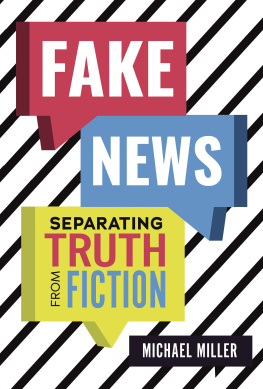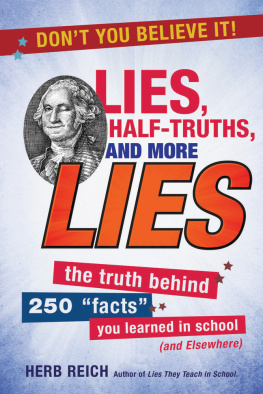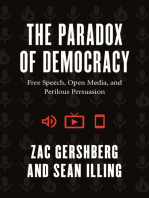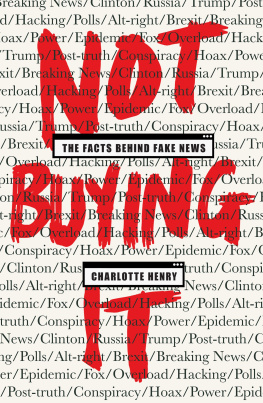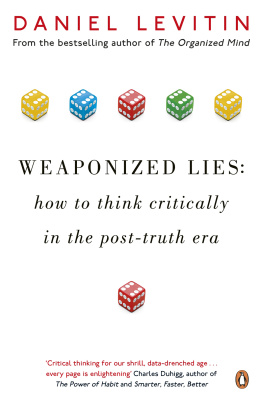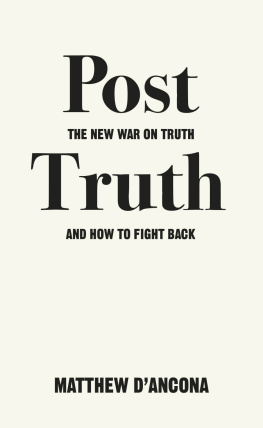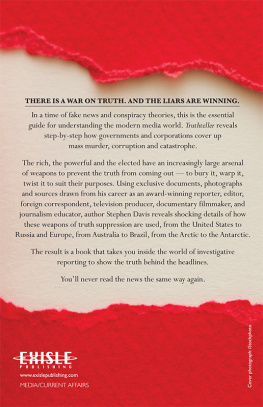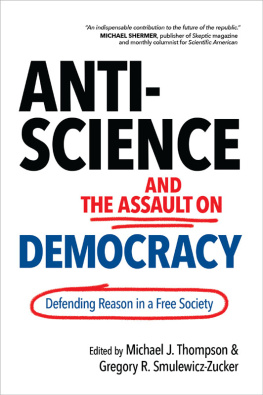Democracy and Truth
Democracy and Truth
A Short History
Sophia Rosenfeld

Copyright 2019 University of Pennsylvania Press
All rights reserved. Except for brief quotations used for purposes of review or scholarly citation, none of this book may be reproduced in any form by any means without written permission from the publisher.
Published by
University of Pennsylvania Press
Philadelphia, Pennsylvania 19104-4112
www.upenn.edu/pennpress
Printed in the United States of America
Library of Congress Cataloging-in-Publication Control Number:
2018051029
ISBN 978-0-8122-5084-8 hardcover
ISBN 978-0-8122-9585-6 ebook
For Matthew
Contents
This book is intended as a short history in two senses. First, the whole amounts to only about two hundred pages. Second, the timeframe has been radically circumscribed; it covers not the entire story of democracy going back to the ancient world but rather its modern manifestation since the eighteenth century. The central premise is that a historically particular and even peculiar relationship between democracy and truth took root roughly two hundred fifty years ago on both sides of the Atlantic, and this relationship has shaped political life into the twenty-first centuryin the United States and with important variations, in capitalist democracies around the globe. To understand the apparent crisis in truth today requires grappling with this history.
What this glance backward reveals, first and foremost, is that truth under the conditions of modern democracy has always been fragile. Truthmeaning doubly the opposite of lies (in moral terms) and the opposite of mistaken beliefs and erroneous information (in terms of epistemology)has been touted as a key democratic value from the get-go. Republics and, later, modern democracies have long prided themselves on both building on and generating truths in ways that constitute a striking departure from absolutist rule, whether in the mold of King Louis XIV or in the style of the modern dictator. Thats why the seemingly brazen flourishing of misinformation and falsehoods in public life now can strike us as so shocking. And yet, democratic truth has never had any precise contours or content. Even if honesty, transparency, and factuality have, since the Enlightenment, been held in high regard as political values, truth has generally been understood not as dogma, but as the product of multiple constituencies in an inegalitarian world pursuing it according to varied methods and as continually open to fresh challenges and revision. No one can call all the shots. That means truth has also always been precarious, not to mention wrapped up in social strife along class, racial, religious, and educational lines. It has also been regularly subject to attempted hijackingsfrom above and from below, from the left and from the rightas different cohorts have worked hard to try to gain a monopoly on it. This book situates what is happening around us right now in this historical frameworka short one, indeed, but not so abbreviated and present-minded that we cant gain some necessary perspective.
If your hunch is yes, lets consider how you (and others) came to feel this way in the first placeand also why it still matters.
For the past few years, the mainstream press has repeatedly told us the same dark story. Democracy is in trouble in the United Statesand the trouble extends to its very foundations. According to this narrative, citizens are losing their grip on any shared view of reality, the minimum requirement for the collective imagination and instantiation of a collective future.
The evidence appears to be everywhere. Think all the way back to Pizzagate, the bizarre, widely discussed 2016 story of an alleged child-sex ring being run by the Democratic Party out of the basement of a D.C. pizza joint. To this day, retellingsat least in the circles of the worriedinspire laughter, but also expressions of dismay. Laughter because, on the surface, the story is so preposterous. Dismay because, like many other such improbable, quasi-political hoaxes and conspiracy tales these days, it actually had its adherents, who can easily locate one another online. One believer even traveled to Washington, armed, looking to self-investigate on behalf of his aggrieved and mistrustful ideological compatriots. This is but the inverse of the hordes of school-shooting deniers who have been harassing teenagers in Parkland, Florida, convinced that the adolescent survivors of a 2018 high school mass murder arent traumatized activists but rather crisis actors, starring in an entirely faked piece of antigun propaganda.
We now know that many of these Internet-fueled fairytales were concocted with the support of Russian intelligence forces and disseminated with the help of bots or troll-factories aiming to spread chaos in the run-up to the 2016 presidential election and beyond. They have also been helped along by giant, international web-based media platforms like YouTube and Facebook and search engines like Google looking, as always, for profits. Todays world of online news is full not just of partisan stories but also of false ones, designed to scare, anger, and mislead for political or mercenary ends.
Its not just a question of new media, though. Cable TV, talk radio, and even much of print journalism also relentlessly generate and push misleading stories or exaggerate the significance of real ones, often with the claim that they are supplying balance. Spokespeople in Washington, from heads of advocacy groups to members of Congress, do the same. Fake audio and video may soon be so convincing that we will no longer be able to distinguish them from the real anyway.
Then there is the current president himself, Donald Trump, widely considered both a symptom and an accelerant of our move away from any shared standards of truth. With his public pronouncements, whether on Twitter, at live rallies, or during visits to Fox & Friends, our former reality TVstar president has exacerbated the problem. He has also, with the support of a large cast of elected and unelected characters, added his own twists.
Trump, it is widely acknowledged, has always brazenly traded in misinformation. He makes up facts about his own past actions. He passes along tall tales from dubious sources. He denies the validity of legitimate information. And he keeps peddling these falsehoods even when they contradict his own or associates previous claims. That goes for accusations and self-justifications alike. Youve heard them all before: hes worth ten billion dollars; Muslims celebrated in New Jersey on 9/11; Obama isnt an American citizen; the tax cuts are going to hurt his rich friends and his own bottom line; there are terrorists from the Middle East hiding out in a caravan of Central American invaders; he never referred to shithole countries in Africa; climate change is a Chinese hoax; voter fraud is rampant; his personal health is magnificent; Democrats forced the breakup of families at the southern border because its their law; hes been exonerated in the Mueller investigation; 3,000 people didnt die in a hurricane in Puerto Rico; and he doesnt know Stormy Daniels, except when he does. The list is long. The Washington Post says he made more than 2,000 false or misleading (as in the case of extremely exaggerated or selective) statements in his first 355 days in office, or about 5.6 per day.
But it is his response when shown legitimate proof to the contrary that draws our attention as much as the original lies. One of his favorite strategies when under fire is to suggest that all truth is slippery because it depends on In Trumpland, truth becomes falsehood, and falsehood masquerades as truth. The credibility of
Next page

